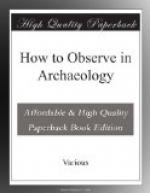The periods and styles that are now recognized are shown on the diagram—and their conditions were:
Style Climate Sea level
Eolithic (Pliocene) ?
Rostrocarinate (Crag) ?
Strepyan warmer lower
Chellean warm low
Acheulian cooler rising
Mousterian cold high
Aurignacian less cold lower
Solutrean warmer low
Magdalenian colder rising
Neolithic as present
Differences of heat may be 20 degrees or 30 degrees
+ or —
Differences of level may be 600-800 ft. + or —
The information required of all observers is the level and conditions of all flint tools that they may see or collect.
Gravels containing tools may be surface gravels on a plateau; note then the level, and the relation of them to any cliffs; do they end abruptly at a cliff edge, showing that the valley was filled up; or do they fade away to the edge, showing that they are older than the valley erosion? Gravels may be the filling up of a valley which was previously eroded; note the highest level at which they can be traced; often little pockets of deposit, or traces of sandy strata, can be found clinging high up on cliffs; also note the depths in the gravel at which any tools are found. Any shells or bones in the gravels are of the greatest value; the depth at which they are found should be written on them at once, with the locality.
Surface flints should have levels noted on them. If sharp they show that probably submergence has not reached that level since; if worn, then water has been up to a higher level, from which they have been washed down.
Levelling may be read from a contour map, if there is such available. In most countries it must be done by reading feet on an aneroid barometer, set with zero of level scale to 30 ins. or 760 mm. Then visit as soon as possible some point where a level is marked on the map, as a hill top, and read the barometer. This will give the correction to be made to all the previous notes. If there is no level recorded, get down to a stream bed (the larger the better) and read it there, recording the exact place on the map. The level may then be worked out approximately by points above and below on the stream, for accurate reading, hold the aneroid face up, gently tap it, and read; then face down similarly, and take the mean. Guard that the wind does not blow against any keyhole in the case.
Pencil all levels and localities on flints as soon as found. Ink in the notes on the least prominent parts of the flint, in small capital letters, when in camp, with waterproof China ink.




